Cite this document
(Information System Requirements Analysis for Clean Brite Company Case Study, n.d.)
Information System Requirements Analysis for Clean Brite Company Case Study. Retrieved from https://studentshare.org/information-technology/1548975-course-work
Information System Requirements Analysis for Clean Brite Company Case Study. Retrieved from https://studentshare.org/information-technology/1548975-course-work
(Information System Requirements Analysis for Clean Brite Company Case Study)
Information System Requirements Analysis for Clean Brite Company Case Study. https://studentshare.org/information-technology/1548975-course-work.
Information System Requirements Analysis for Clean Brite Company Case Study. https://studentshare.org/information-technology/1548975-course-work.
“Information System Requirements Analysis for Clean Brite Company Case Study”, n.d. https://studentshare.org/information-technology/1548975-course-work.


